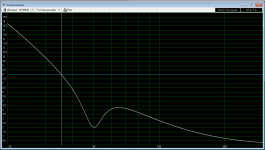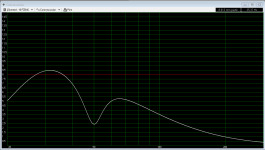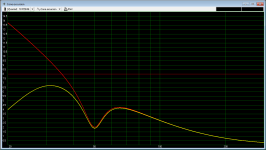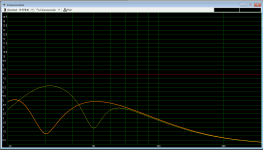Hi all!
I have 2 B&C 18PZB46 and 2 B&C 18PS46 woofers.
They're all in identical 185L sub boxes. (185L without the woofer, is that the correct figure to use?)
Right now all these boxes are tuned to about 50Hz,
However they don't sound as great and get as loud as I'd hope
Is there anything I can do to the tuning frequency to help with some of my problems? Any other solutions are appreciated as well of course!
I'd rather sacrifice some sound quality and have them be a bit louder, than the other way around. Some distortion isn't THAT big of a deal.
I've also added the WinISD calculations I've done, but I'm not completely sure if they are correct, since I'm not too experienced
Thanks in advance!
-Daan
Datasheets
18PZB46: https://www.bcspeakers.com/media/W1siZiIsIjIwMTMvMDMvMTEvMTUvNTIvMzAvNTQyL2ZpbGUiXV0
18PS46: https://www.bcspeakers.com/media/W1siZiIsIjIwMTMvMDMvMTEvMTUvNTIvMjYvMTE2L2ZpbGUiXV0
I have 2 B&C 18PZB46 and 2 B&C 18PS46 woofers.
They're all in identical 185L sub boxes. (185L without the woofer, is that the correct figure to use?)
Right now all these boxes are tuned to about 50Hz,
However they don't sound as great and get as loud as I'd hope
Is there anything I can do to the tuning frequency to help with some of my problems? Any other solutions are appreciated as well of course!
I'd rather sacrifice some sound quality and have them be a bit louder, than the other way around. Some distortion isn't THAT big of a deal.
I've also added the WinISD calculations I've done, but I'm not completely sure if they are correct, since I'm not too experienced
Thanks in advance!
-Daan
Datasheets
18PZB46: https://www.bcspeakers.com/media/W1siZiIsIjIwMTMvMDMvMTEvMTUvNTIvMzAvNTQyL2ZpbGUiXV0
18PS46: https://www.bcspeakers.com/media/W1siZiIsIjIwMTMvMDMvMTEvMTUvNTIvMjYvMTE2L2ZpbGUiXV0
Attachments
Hi Daan,
There's certainly a lot I'd do differently if I were trying to start a new project with these drivers, however most of it is not going to help them get louder.
One of the important characteristics to pay attention to is Excursion - in both your project files you've got them pushed to ~12mm, whereas Xmax is only 6 or 8 mm.
So, if you're actually running them this loud already, you've probably already got quite a lot of distortion going on.
Next up, you say they're tuned around 50Hz, but your models show a 40Hz tune - have you actually confirmed the tuning in the real world? You got some advice how to do that in your thread from last October, so it may be worth re-reading that.
Next, for modelling, the program needs to now the volume of the empty space in the box, after accounting for not only the drivers but also ports, bracing, handles etc. Those latter items may not make a huge difference in the end result, but if you're trying to squeeze the most performance out of older drivers, it's worth being as accurate as possible.
I see you've modelled 2 different frequency response shapes - if you use the 2 different drivers together, I'd re-do your filters to get them all sounding as similar as possible, as long as that doesn't result in you over-driving the PS drivers with their lower Xmax.
There might be more that can be improved, but if you could confirm the info about the current tuning frequency of the box that would be a good start.
The bottom line however is that these are quite old drivers, so even in perfectly new condition they would be quite limited in performance, and we don't know how hard they've been driven over their lifespan so they may not even perform up to that standard.
Cheers,
David.
There's certainly a lot I'd do differently if I were trying to start a new project with these drivers, however most of it is not going to help them get louder.
One of the important characteristics to pay attention to is Excursion - in both your project files you've got them pushed to ~12mm, whereas Xmax is only 6 or 8 mm.
So, if you're actually running them this loud already, you've probably already got quite a lot of distortion going on.
Next up, you say they're tuned around 50Hz, but your models show a 40Hz tune - have you actually confirmed the tuning in the real world? You got some advice how to do that in your thread from last October, so it may be worth re-reading that.
Next, for modelling, the program needs to now the volume of the empty space in the box, after accounting for not only the drivers but also ports, bracing, handles etc. Those latter items may not make a huge difference in the end result, but if you're trying to squeeze the most performance out of older drivers, it's worth being as accurate as possible.
I see you've modelled 2 different frequency response shapes - if you use the 2 different drivers together, I'd re-do your filters to get them all sounding as similar as possible, as long as that doesn't result in you over-driving the PS drivers with their lower Xmax.
There might be more that can be improved, but if you could confirm the info about the current tuning frequency of the box that would be a good start.
The bottom line however is that these are quite old drivers, so even in perfectly new condition they would be quite limited in performance, and we don't know how hard they've been driven over their lifespan so they may not even perform up to that standard.
Cheers,
David.
Thanks for your reply!
Sorry, I forgot to mention that the WinISD calculations are for 40Hz tuning, which is what I wanted to change the boxes to originally.
Now I'm starting to doubt that though, as 50Hz tuning gives me a bit more SPL. The boxes are still tuned to 50Hz now, which I also have verified.
About the Xlim/Xmax. I've acually sent B&C an E-mail about this, and they said that for both woofers +/-12mm is the max to prevent a 'massive non linear excursion', and beyond +/- 14,5mm permanent damage may occur.
However, I do agree with you that I'm pushing them quite hard indeed, like I said, I'd like them to be quite a bit louder.
I also didn't really consider/know that them being this old could have quite the effect on performance, so maybe I'll just have to live with it 😛
-Daan
Sorry, I forgot to mention that the WinISD calculations are for 40Hz tuning, which is what I wanted to change the boxes to originally.
Now I'm starting to doubt that though, as 50Hz tuning gives me a bit more SPL. The boxes are still tuned to 50Hz now, which I also have verified.
About the Xlim/Xmax. I've acually sent B&C an E-mail about this, and they said that for both woofers +/-12mm is the max to prevent a 'massive non linear excursion', and beyond +/- 14,5mm permanent damage may occur.
However, I do agree with you that I'm pushing them quite hard indeed, like I said, I'd like them to be quite a bit louder.
I also didn't really consider/know that them being this old could have quite the effect on performance, so maybe I'll just have to live with it 😛
-Daan
OK, that's helpful, thanks.
The 50Hz tuning does help to maximise the SPL, so if that is your priority I would recommend leaving that as is (at least until you can afford different drivers, if that were something you'd consider at some point).
It also helps control excursion, so the likelihood of excessive distortion is less too.
I know in your other thread you said that you did try a lower tuning, which made them sound better but you weren't happy with the loss of maximum volume - did you ever test that at gigs or was it just tried out at home?
The only reason I ask is that depending on the type of music being played, that deeper extension can sometimes outweigh the loss of max volume.
Cheers,
David.
The 50Hz tuning does help to maximise the SPL, so if that is your priority I would recommend leaving that as is (at least until you can afford different drivers, if that were something you'd consider at some point).
It also helps control excursion, so the likelihood of excessive distortion is less too.
I know in your other thread you said that you did try a lower tuning, which made them sound better but you weren't happy with the loss of maximum volume - did you ever test that at gigs or was it just tried out at home?
The only reason I ask is that depending on the type of music being played, that deeper extension can sometimes outweigh the loss of max volume.
Cheers,
David.
I might consider buying some new drivers at some point, or maybe some completely new EV subs of something. But right now I unfortunately dón't have a budget for this.
I mainly tried them out at home, but also at some gigs. The things is though, that the music played can be anything really so I guess I'll just go with the 50Hz tuning for the extra SPL
-Daan
I mainly tried them out at home, but also at some gigs. The things is though, that the music played can be anything really so I guess I'll just go with the 50Hz tuning for the extra SPL
-Daan
Subs unload below the tuning frequency.
So higher tuning just unloads them faster.
97 dB to 96dB is the sensitivity so not much else to do to increase that.
To get more power in and protect from unloading.
A vented sub needs over excursion protection.
Which is usually a 4th order high pass filter
set about 7 to 12 Hz below tune frequency (Fb)
Usually a normal BB4 alignment will be a decent hit for a sub.
So higher tuning just unloads them faster.
97 dB to 96dB is the sensitivity so not much else to do to increase that.
To get more power in and protect from unloading.
A vented sub needs over excursion protection.
Which is usually a 4th order high pass filter
set about 7 to 12 Hz below tune frequency (Fb)
Usually a normal BB4 alignment will be a decent hit for a sub.
As with any reflex.
Whatever the tuning is that is where the cone movement is very little.
Basically any accuracy or transient response is pretty much gone.
From that point down. Easily visible in Cone excursion screen.
Also visible would be how much power you can actually apply
and what frequency it is unloading at 10% distortion ( xmax)
Looking at the 18PZB46 in 185 liters 50 Hz Fb
With 250 watts its unloading at 35 Hz 8mm
and at 20 Hz would be close to hitting the plate.
or physical damage.
Cone movement very little at 50 Hz
No transient or accuracy. And movement is already
getting limited at 60 Hz.

Now with 4th order Over Excursion protection High pass filter
Set to 25 Hz .707 Q
Unloading is reduced and you can apply 450 watts instead of
only 250 watts.

Or for a more visible difference can apply same power
with and without the high pass to see how it reduces unloading.

Whatever the tuning is that is where the cone movement is very little.
Basically any accuracy or transient response is pretty much gone.
From that point down. Easily visible in Cone excursion screen.
Also visible would be how much power you can actually apply
and what frequency it is unloading at 10% distortion ( xmax)
Looking at the 18PZB46 in 185 liters 50 Hz Fb
With 250 watts its unloading at 35 Hz 8mm
and at 20 Hz would be close to hitting the plate.
or physical damage.
Cone movement very little at 50 Hz
No transient or accuracy. And movement is already
getting limited at 60 Hz.

Now with 4th order Over Excursion protection High pass filter
Set to 25 Hz .707 Q
Unloading is reduced and you can apply 450 watts instead of
only 250 watts.

Or for a more visible difference can apply same power
with and without the high pass to see how it reduces unloading.

18PS46 T/S max flat = ~162 L net, 36 Hz Fb
18PZB46 = ~117 L net, 40 Hz Fb
If averaged out, then ~137 L net (after driver, etc., is subtracted), 38 Hz Fb, so to get them to perform ~ as one overall in theory, use bricks or other ~non resonant material to reduce them and re-tune. This of course presumes the specs were originally accurate enough with ~ the same work 'weariness'.
18PZB46 = ~117 L net, 40 Hz Fb
If averaged out, then ~137 L net (after driver, etc., is subtracted), 38 Hz Fb, so to get them to perform ~ as one overall in theory, use bricks or other ~non resonant material to reduce them and re-tune. This of course presumes the specs were originally accurate enough with ~ the same work 'weariness'.
pretty much.
50 Hz boost is common for sub, but would prefer EQ to obtain same sound.
So reflex can be tuned much lower. And will have better transient response.
Instead of using high tuning and too large of box.
As noted the speaker does well in 117 liters.
dual spider 18" seems rather impressive. But also common for larger cones.
To have equal port pressure of 4 ports total , one in each corner.
Cone rocking is less likely with the extra spider. But still use to old school
Methods with large cones.

As you can see with lower tuning. 50 Hz is now actually produced with
electrical cone movement. And when boost is applied will be very accurate.
And before where system was unloading. The cone restriction from the reflex
creates a nice " brake" or cone control. And accuracy is somewhat good down to 40 Hz
as before 40 Hz was just unloading.
50 Hz boost is common for sub, but would prefer EQ to obtain same sound.
So reflex can be tuned much lower. And will have better transient response.
Instead of using high tuning and too large of box.
As noted the speaker does well in 117 liters.
dual spider 18" seems rather impressive. But also common for larger cones.
To have equal port pressure of 4 ports total , one in each corner.
Cone rocking is less likely with the extra spider. But still use to old school
Methods with large cones.

As you can see with lower tuning. 50 Hz is now actually produced with
electrical cone movement. And when boost is applied will be very accurate.
And before where system was unloading. The cone restriction from the reflex
creates a nice " brake" or cone control. And accuracy is somewhat good down to 40 Hz
as before 40 Hz was just unloading.
Last edited:
Yeah, way back when 3-5 mm Xmax was the norm, Altec, EV, etc., tuned prosound cabs using a simple Vas/1.44, Fb = 1.56x Fs with typically plenty of mid-bass peaking that passed for a strong/'thumping' bass back then and rapid VC heating EQ'd somewhat, but this was based on a 40 Hz/F-24 dB, so nowadays need some sort of hi-pass filter.
You can apply a 48db filter just below reflex tuning frequency. A behringer inuke nu3000dsp or deq2496 can do that.
At 45 hertz set you can put more power into the box.
Placement of the bass plays a role.
Put against a back wall or in a corner you get a lot more bass output.
In the corner +9db some say even more.
If you want you can put the drivers in some proper dimensioned horns.
At 45 hertz set you can put more power into the box.
Placement of the bass plays a role.
Put against a back wall or in a corner you get a lot more bass output.
In the corner +9db some say even more.
If you want you can put the drivers in some proper dimensioned horns.
Oh I didn't know this would have such an big impact on cone excursion!
I actually have a DCX2496 so I'll be using that for the HPF
I'll have to check how this affects sound quality though.
But thanks for the tip!
As for placing them in a corner/next to a wall. If possible I'll always try to do that
I actually have a DCX2496 so I'll be using that for the HPF
I'll have to check how this affects sound quality though.
But thanks for the tip!
As for placing them in a corner/next to a wall. If possible I'll always try to do that
Last edited:
- Home
- Loudspeakers
- Subwoofers
- Can't figure out subwoofer tuning